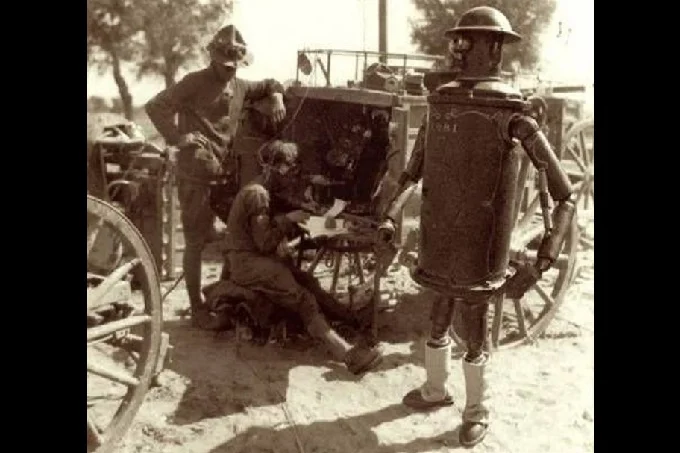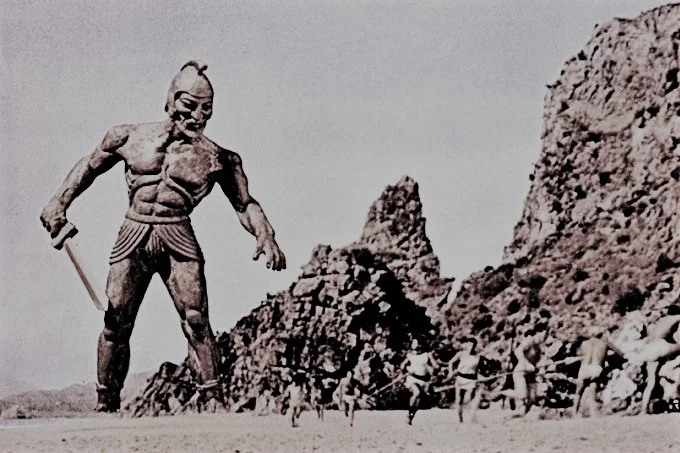Combat walking machines: The secret of iron man

It wasn’t until the middle of the 19th century that combat walking machines made their debut in the pages of science fiction. This was about the time when steam and electric mechanisms had firmly established themselves in real life and were no longer connected with being unbelievable.
However, Jules Verne was unable to ignore the walking giants, who in 1880 took the form of enormous steam elephants on the pages of the Steam House and in 1897 were shown as wicked Martians standing on tripods.
At the tail end of the 19th century, one might quite frequently encounter actual steam people on the pages of literary publications. These individuals served as a type of renewed version of Tin Woodcutters. It was in good old England, which at the time was a leading nation in both the economic and industrial spheres, that the first character of this kind debuted. As a result, the emergence of the steam man formed a natural connection to the lives of literary heroes.
Johnny was driven to the creation of this innovation by a series of twists of destiny. The youngster, who was born with a hump as a consequence of an accident sustained before birth, grew up to be quite reclusive. Johnny may have lost his father at a young age, but he was able to inherit his skill and spend hours creating self-propelled toy carts, ships, and steam locomotives. His father was a talented designer and the inventor of multiple patents.

When the inventor reached adulthood and found that playing with toys, even ones that could drive themselves, would not satisfy his need for stimulation, his mother suddenly proposed that Johnny build a full-fledged steam-powered man. Brainerd got to work on the project with all of his zeal, and after a long period of time, the iron man was finally ready.
The following is a description of the innovation as it appears in the novel: “This powerful giant stood around three meters tall, and not even the strongest horse could compete with him. The giant effortlessly dragged a wagon that included five people. In place of the headgear typically worn by individuals, the Steam Man had a chimney stack from which billowed dense, dark smoke.
The body of the mechanical man was covered in a dark coat of paint, and its components, including the face, were composed of iron. The remarkable mechanism had a set of eyes that seemed to be startled and a large mouth that appeared to be grining. He had something in his nose that looked like the whistle from a train and it was a hole through which steam could escape. In place of a chest, he had a steam boiler that had a door on it through which logs could be thrown.
The pistons were kept in place by two of his wrists, and the soles of his gigantic, long legs were coated in razor spikes to keep him from sliding. He had reins around his neck and flaps on his back in the form of a rucksack that the driver used to manage the Steam Man. Additionally, there was a cable that ran on the left side of his body that was used to operate the whistle that was located in his nose. When operating under ideal conditions, the Steam Man was capable of reaching very high speeds.
Our train, please go one step farther!
On rural roads, however, the Steam Man’s cart, which he drove, would shortly be left without wheels if he attempted to go at this maximum speed of 30 miles per hour, which is equivalent to around 48 kilometers per hour. Even well-maintained pavement presented a significant risk to her.

Because the steam boiler was a self-contained unit, it required frequent refueling with firewood, which, as a matter of course, had to be brought along with the traveler or somehow discovered along the road. Even though the issue with water was less severe, the inventor nevertheless lost interest in his creation in 1875 and sold the patent for the mechanism to Frank Reid, Sr., who then started to enhance it.
Frank was able to construct a machine in only one year that he named the Steam Man Mark II after himself after effectively applying all of the accomplishments that his predecessor had accomplished. The man and the locomotive both grew to be 3.65 meters taller, headlights were installed in place of eyes, the piston system was strengthened, and lighter alloys were incorporated into the structure. These improvements enabled the locomotive to achieve speeds of up to 50 miles (about 80 kilometers) per hour.
Also, the “driver” did not need to clear the firebox from ash by poking holes in it with a poker anymore since the ash just dropped out on its own via special channels located at the bottom of the automobile. On the other hand, there was evidently some type of rock that floated above the “steam people.” After a time, Frank Reed Sr. also became bored of him, and he put all of his energy on developing electrical beings instead.
Only one time did Frank have to take the Steam Man Mark II out of its hiding place: the story has it that in February of 1876, in the midst of a big throng of people, he organised a race between his iron runner and another one, the Steam Man Mark III (apparently, the design of his own son). However, it was not made clear which of the models emerged victorious in the competition.
Robot from World War I
The date of November 27, 1862, was yet another pivotal moment in the plight of the “steam people,” who had hitherto only been seen on the pages of fictional works. Archie Campion, who would go on to become the person responsible for the creation of such a device, was born in Chicago on this particular day. According to the information provided in his biography, the death of the boy’s sister’s husband during the war (which appears to have been the Civil War) left the young man with such a profound sense of loss that he resolved to create a device that would put an end to all armed conflicts in the world. And before long, the possibility materialized itself.
In the year 1878, Archie started working for the Chicago Telephone Company, where he was immediately immersed in the world of science and technology. After another five years, he had already accumulated a number of patents for a wide variety of technological equipment, such as folded pipelines and electrical systems with many stages.

Due to the consistent withdrawals from his paycheck, the young man quickly became a billionaire when several of his inventions found usage on the enormous Westinghouse Electric. This finally afforded Archie the chance to begin working on the infamous method of stopping wars, and in 1888, he established a laboratory in the vicinity of Chicago in order to do so. The solution was ultimately a steampunk-inspired terminator in the form of a humanoid Boilerplate (derived from the English phrase “boilerplate,” which may be translated as “boiler sheet” or “thick sheet iron”).
Campion developed it for the World’s Columbian Exposition in 1893, but for some reason, the mechanism did not experience success at it. The next year, Campion embarked on a sailboat to Antarctica with undefined intentions in mind. However, the ship was unable to reach the penguins because the ice was too thick, so the robot went back to the continent and waited for the Spanish American War of 1898, which was the purpose for which it was originally designed. The appeal of the inventor to President Theodore Roosevelt to enroll the mechanical man in the army as a volunteer was granted, and the president thanked the inventor for his efforts.
It is true that Boilerplate’s participation in the conflict was unable to end it; nonetheless, he survived it uninjured and, in 1916, he took part in the arrest of the Mexican revolutionary Pancho Villa, during which he was caught. Boilerplate was taken prisoner during this operation. The following is a description of what happened from eyewitness Modesto Navarez: “All of a sudden, someone yelled that an American soldier had been taken prisoner to the north of the city. Eventually, he arrived at the hotel where Pancho Villa was staying.
I got the chance to see this for myself, and I can honestly say that in all my years of living, I have never come across an unknown soldier. This American was not a man at all since he was entirely composed of metal, and he towered above all of the other troops by a whole head. He was also far taller than the other civilians. Because of the way the blanket was wrapped over his shoulders and the way it was knotted, he seemed to be an average peasant from a distance.
After some time had passed, I was informed that the sentries had attempted to halt the metal figure with rifle fire, but the bullets were like mosquitoes for this behemoth. This soldier just requested to be brought to the commander and did not attempt to get revenge on those who had attacked him. ” As one would expect of a hero, Boilerplate vanished into thin air: in 1918, he embarked on a covert mission in the German rear, and he was never seen again. Since that time, no one has reported seeing the gigantic mechanical creature…




